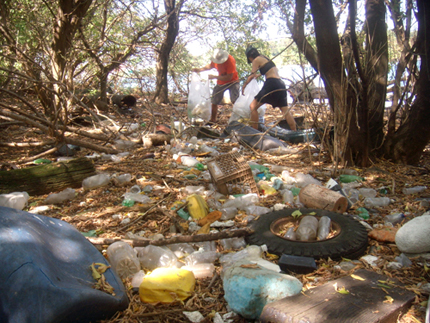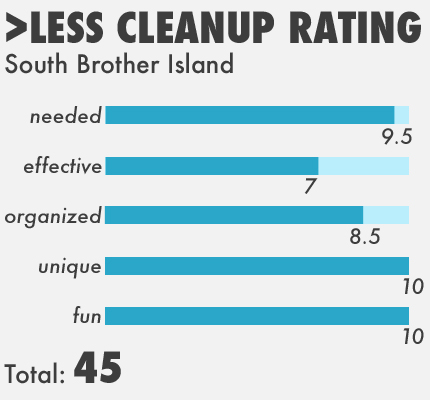South Brother Island 9/25
Because most of the NYC cleanups did coincide with the established ICC date of September 25th, I had to forgo many of the cleanups and choose the most desirable site listed for this day. South Brother Island (SBI), an uninhabited and off limits island just a few hundred meters west of Rikers Island, was an appealing choice. Unlike all the other NYC cleanup sites, SBI is inaccessible to pedestrians, motorists, and bicyclists as it lacks any bridge or roadway from the mainland. Thus one can only get to the island via seafaring vessels, which is why the cleanup is led by members of the Long Island City Community Boathouse (LICCB) who take volunteers up the East River in kayaks to reach the island. As a kayaker myself, I was quick to get in touch with the trip leader Erik Baard about joining this years expedition, who was happy to accommodate a spot for me on the trip.
The trip was timed to coincide with the tides. We would leave just after low tide in the morning, ride the waters northeast from Long Island City, Queens through Hells Gate onward to SBI and do the opposite on our return trip by riding the ebb tide back to the boathouse. This provided us with enough time to eat lunch (at Barretto Point Park in the Bronx) and execute a plan for cleaning as much of SBI as possible.
I passed on bringing my own kayak, and had the great fortune of joining 5 others in a handbuilt rowboat for the northbound journey. On the return trip I joined the kayakers, paddling a folding frame vessel with a NYC subway map transposed on the skin, the aptly named Metroboat.
Aside from figuring how to get 20 people to an uninhabited island, the schematics of the cleanup included the coordination of a proper way to transport trash from the island to the mainland (Barretto Point Park), as well as formal permission to step foot on the off limits city property. For the former, Erik recruited a friend with a motor boat to help move the collected trash, which seemed an improvement over the previous years method of loading up an empty kayak to be towed by two separate kayaks (a plan that ultimately fell short, leaving a large collected pile left on the island due to time and space constraints on the improvised barge). For permission, Erik was able to secure a permit from the city, as well as a parks department ranger to chaperon the cleanup efforts. He provided a brief, yet informative, lecture on the island and purpose it serves as a protected breeding ground and coastal habitat for birds.

For an uninhabited piece of land, SBI housed a great deal of debris created and used by humans. Having spent some time exploring and learning about how currents and oceanic patterns can transport flotsam (this book is a must read), I was pretty excited to rummage through all of the washups. In fact, I found myself racing out ahead of the other volunteers so as to see and examine all of the trash before it was bagged. I did not want to miss out on seeing and/or keeping items of interest. I did mention to everyone that I collect plastic lighters, and would appreciate receiving any lighters that were found; a request that I was happy not to have ignored. (I realized that this feeling of frantic racing to examine all of the debris before collection by others would be a theme as I visited other ICC sites.)
A majority of the trash on SBI was, as Erik mentioned in his instructional pregame talk, plastic bottles. Other common items included car tires, sporting balls, and plastic containers. The largest abundance of waste was found not on the actual shoreline, but a few dozen feet inland, past the edge of vegetation that encompassed the inner island, supposedly from high surges that had pushed the water level further toward the center. After some rapid collection amongst a rather large and dense pile near our starting point (see photo above), I continued on past the others to find the opposite side of the island. Here I still ventured into the inner woodlands to find the most washed up debris and in turn discovered a few bird carcasses, as well as difficult to dispose of items such as large plastic pieces covered in soil, and a full bottle of motor oil. I continued around the island, which became more difficult to navigate, running into only one volunteer headed the opposite direction on a circumnavigation, Ted Gruber of the LICCB.
After skirting around some reeds and through the water on the southern coast I made my return to our starting point. The motorboat was being loaded up and I added my bags to the pile just prior to take off. As it turned out the boat had already made one trip to the mainland and back, which means I was much slower than others in collecting and almost missed the boat, so to speak, all together.
A few brave souls squeezed onto the garbage boat to help haul all of the collection to the proper disposal place. Apparently the parks department made it very clear that they did not want to help move the trash but rather instructed Erik (see his photos here) and others to haul the garbage through the park, to the proper curbside collection point on the street. As this took some time, those left on the island were afforded some free time, with no pressure to collect remaining trash as the boat had made its final haul. While this did mean that we left some garbage on the island and did not clean it entirely, it also meant I had time to swim in the beautiful September sunbathed waters off the eastern shore of this uninhabited island. Clean, calm and peaceful waters less than a mile from three of NYCs most uninviting environments: the rough streets of the South Bronx, the ultra-industrial landscape of ConEds mega powerplant in Astoria, Queens, and NYCs infamous prison, Rikers Island.
|
|
Index
Intro <1
South Brother Island <2
Great Kills Beach <3
Aviation Road <4
Lemon Creek Park <5
Others <6




Interview with Erik Baard
What was your interest in leading a cleanup on ICC day?
I founded the LIC Community Boathouse to power a positive feedback loop. People recreating in a natural place become emotionally healthier and come to value their environment and their place in it. They are moved to care for the health of the estuary, and feel stronger for seeing their achievements grow and the joy they bring to others. Newcomers to paddling, over the course of generations, in turn benefit from even more beautiful, cleaner, natural spaces. With a sense of history, taught by elders who contributed to this wonderful restoration, each new generation might work to improve our harbor with even greater ardor. Coastal cleanups are a perfect entry into this virtuous cycle, because we can see our effects immediately. As participants remove plastic trash from our shorelines, they discover a wealth of crabs, mollusks, seaweeds, birds, fish, seagrasses, and other members of their living community. They hunger to see more, and the adventure of paddling provides this reward.
How did you come to choose South Brother Island?
I have always been drawn to the beauty of South Brother Island. When I paddled close to the northeast shore, however, I saw the island was under assault. Seeing an ecosystem and urban interlude of grace yielding to plastic was like seeing a gem ground into dust. I had to act. By staging annual cleanups, and inviting people with influence and access to money to participate, I hope we'll eventually draw enough resources to the island's proper care.
How could International Costal Cleanup day be more successful?
A smart phone or iPad interface, so that tabulations can be done on site.
What other NYC coastal spots need some serious cleanup attention?
I would love to see Flushing Creek and Flushing Bay more fully adopted by the thriving communities ashore.

|
|

